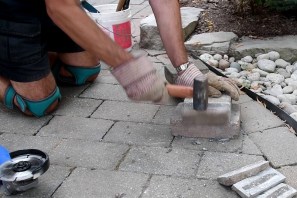If you’ve ever watched interlock paving being installed, you will probably have seen a gas-powered diamond-tipped monster saw being used to slice through the paving stones to accommodate a precise fitting. When you have a handful of cuts to make, getting a paving contractor to come out to lay the stones is probably impossible, and doing it yourself means buying or renting a saw, and overcoming your fear of losing a limb. But there’s a cheaper way.
Go directly to my YouTube video
Angle grinder and safety

I got my angle grinder late in my DIY life, and didn’t realize what I was missing until I finally succumbed to a sale at Canadian Tire and came home with an angle grinder, on sale for about $19. My initial requirement was cutting off nails which were not accessible for regular extraction. I had also at some time purchased a small diamond blade which I had used in a circular saw for cuts in a concrete floor. That experience wasn’t very satisfactory. Then one day I found that the blade would fit on the angle grinder. I checked that the blade was rated for the speed the grinder would run at, and decided to give it a go. This was a much better experience!
Please heed all the safety warnings for the grinder and saw blade. Especially the one about using the blade guard. One extra precaution is to take care during the time the blade spins down after you switch off. I found there was a tendency for the blade momentum to loosen the nut that holds the blade on, regardless of how tight I made it. So check the nut is tight every time and be careful where you are pointing the tool while it spins down in case the nut comes right off!
Someone who watched my video pointed out that the way I oriented the saw to shoot the dust away from me is more dangerous than turning the saw the other way, with dust coming back. Should the blade bind and kick back, the way you see me doing it could result in the tool flying up and back towards me, while the other way would tend to move it down and away. Take heed.
Cutting a paving stone
There really isn’t much to learn which isn’t common sense. Safety first, hand and eye protection, and keep your body out of the line of fire (so to speak). There will be a lot of concrete dust, so find a place where this will not be an issue. While a fairly large stone is not going to move much, if you are cutting a smaller stone, you will need a way to safely hold it still. You will sense the tool cuts best with very little pressure, so your involvement is to keep it on the line (which will be easy as soon as the blade starts to cut a groove), keep the blade moving and be sure not to twist the blade in the cut.
In my particular application, I wanted air space between the paver and some wood, so that the wood would not rot. If it wasn’t for rotting wood, I wouldn’t have needed to re-lay pavers! Anyway, I chose to cut at an angle so that the top was longer than the bottom. This is not a bad idea anyway, as it makes fitting easier. Anyway, this meant all the cuts were at an angle. It may be marginally easier to make the first cut at 90, and then tilt over to the required angle in subsequent cuts, with the blade running in the fresh groove to keep it on the line.
Depth of cut

The blade is relatively small, and the body of the grinder takes away some of the blade capacity, so you will get less than half way through a regular paving stone. I choose to cut the two edges of my stones, which extends the line of cut down to the bottom, so it’s easy to then mark a line across the bottom. Or you can do all the marking up front – see what works for you. Once you have top and bottom cut, and possibly the two edges as well, a sharp tap with a hammer should break the excess away.leaving a relatively clean cut. You can decrease your chances of unwanted chipping by lining up a second brick under the cut paver, so there is support right up to the bottom cut line.
Not that hard
I found the whole process very easy. I had about an hour working with the grinder previously, using a grinding wheel, which is more forgiving than a cutting wheel, and I think that helped get the feel of the tool. The cuts were much neater than the ones I made on my very first interlock project – back then we used a stone guillotine with a six foot handle which made a clean cut maybe half the time! Cost-wise, even if you have to buy a grinder, it comes out cheaper than just the diamond blade for a big saw. It takes longer, so it wouldn’t work for a large project, but for a repair job which requires a few cuts, this method is totally practical.
I made a video showing the process:




2 Responses to “Cutting pavers with an angle grinder”
When do we get more?
As it happens, I’m just editing an article on a tamping tool I designed. It should be out this week.